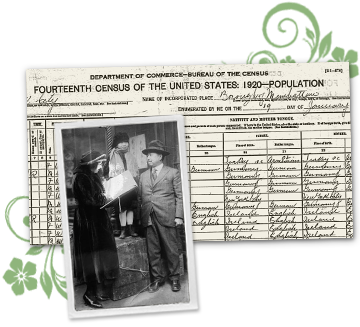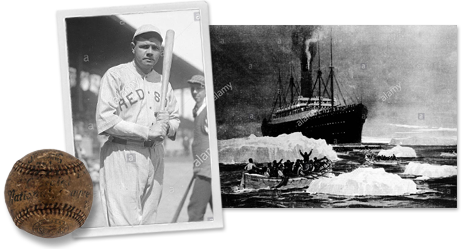US 1920 Census Records
The 1920 Census captured a snapshot of American life, one very different from just 10 years earlier. The decade was a period of innovation and destruction, including Ford’s assembly line and WWI.
Tracing Ancestry with 1920 Census Records
A Portal to the Past
The 1920 U.S. Federal Census is a key genealogical resource, documenting the lives of our ancestors during the transition from the post-war period into the mid-20th century.
These records are archived online on GenealogyBank, bringing the social and economic conditions of the past to life. Whether you are taking the first steps in building your family tree or you just want to add more life and color to what you already know, the 1920 Census is a crucial resource for anyone looking to understand and uncover their past.
Key Insights from the 1920 Census
The US Census is the decennial enumeration of the US residents comprising their occupation, age and family size to obtain demographic information. The detailed records from this era include invaluable information for family historians:
- Family Connections: Know your friends, family, and significant others, also check with them with birthdates, marriage records, yearly census and other vital statistics data.
- Migration Patterns: Discover and explore your roots by uncovering your ancestors’ places of birth and how they came to the States, all are waiting in the migration records.
- Community Context: Explore the neighborhoods where your family resided and uncover the value of their real estate and occupations.
Search Census Records

1920 Census Facts
- Population: 106,021,537 - 15% growth vs the 1910 Census
- Census Date: January 1920
- Census Date Released: 2005
- Number of States Participating: 48 48 (Alaska & Hawaii not yet states) - New states in the 1920 census: Arizona & New Mexico
- US Territories Participating: Alaska, Hawaii, American Samoa, the Canal Zone, Guam, Puerto Rico and the Virgin Islands
- Data Lost: None
- Separate American Indian Schedule: No
Conducting a 1920 Census Search
Efficient Search Strategies
At GenealogyBank, we make accessing the 1920 Census records simple and rewarding, with sophisticated, easy-to-use search tools.
Here’s how to begin:
- Start with a Name: Start with your ancestor's full name, last name, middle name or initials to retrieve accurate records.
- Refine with Keywords: Try adding in town names or other specifics to narrow down your search and hone in on what you’re looking for.
- Exclude Irrelevant Info: Tune out any irrelevant details in your search by focusing on the essentials.
- Order Your Results: Arrange findings either by relevance, or by name, whichever one helps you quickly focus on the essential matches.
Maximizing Research Outcomes
Adapting your approach can lead to richer discoveries:
- Keep individual records for each family member, as it is easy for names to be shared within households (lots of names run in the family!) so you don’t accidentally follow the wrong line of investigation
- Take into account that misspelling and the use of nicknames were common at the time - so don’t discount potential matches based on spelling discrepancies.
- Explore the heritage of people who lived in the same neighborhood as your ancestors, you might uncover a few clues about migratory patterns of your own family connections.
A Foundation for Family History
The 1920 census is a significant census because it gives us the picture of the daily lives of people after the turbulent period after World War I and the Spanish Flu epidemic. It is often through these challenging times that we gain an insight into what made our ancestors and their stories.
From thousands journeying across the country in search of work to the start of women taking a more self-reliant role in the society, the period saw a change in the traditional way of life in America. Through the 1920 census and other records or newspapers from the old times, we can paint clearer picture of our ancestors and grow that connection with our family's past.
1920 Census Questions Asked
The 1920 Census asked four new questions including the year of naturalization and native language. Due to the border changes after WWI confusion arose around the place of origin. Respondents who declared they or their parents were born in Germany, Austria-Hungary, Russia or Turkey, were asked to spell out the city, state, provinces of their origin.
In addition, questions about unemployment on the day of the census or military service in Union or Confederate armies were removed.
- Name
- Location
- Household Data - Number of people, if the house was rented, owned or a farm
- Relation - of the responder to the head of the household
- Personal Description - Sex, race, age at last birthday, marital status
- Education
- Year of immigration to the U.S.
- Naturalized? Alien? Year?
- Place of Birth - noted both US & foreign locations - Father’s & Mother’s place of birth - Father’s & Mother’s native tongue
- Employment - type of work, if they were a farmer
- Veteran & Name of war or expedition
Although a supplemental Schedule for Indian Population was recorded, there were fewer questions compared to previous censuses.

Notable Events Between 1910-1920:
Politics & WWI- Arizona became the 48th state in 1912
- On April 6, 1917, the U.S. joined WWI with the Allies and declared war on Germany.
- On June 28, 1919, the Treaty of Versailles was signed, ending the war.
- By 1911 the first transcontinental airline began operation from New York to Pasadena, California.
- By 1913, the first assembly line launched by Ford.
- The first telephone conversation occurred by Alexander Graham Bell & Thomas A. Watson between New York and San Francisco in 1915.
- Boston’s iconic Fenway Park opened in 1912, Babe Ruth joined the MLB in 1914.
- In April 1912 the Titanic crashed and sank in the North Atlantic Ocean.
1920 Census Data from GenealogyBank
When researching your ancestors, census records are a great place to start. In addition to general report data such as age, place of birth and marital status, census data can uncover details like whether your ancestor was an immigrant or worked in a specific trade. Discover more about this decade and the lives of your ancestors by searching the 1920 US Census. Then, using the details you find in the census, continue your search with our newspaper archives to uncover their stories. Did they work at the Ford Motor factory or were they featured in local newspaper stories about the impact of the assembly line on their jobs? Find out these and more by searching your ancestor’s name in the 1920 Census. Read More
Conducting a 1920 Census Search
Efficient Search Strategies
At GenealogyBank, we make accessing the 1920 Census records simple and rewarding, with sophisticated, easy-to-use search tools.
Here’s how to begin:
- Start with a Name: Start with your ancestor's full name, last name, middle name or initials to retrieve accurate records.
- Refine with Keywords: Try adding in town names or other specifics to narrow down your search and hone in on what you’re looking for.
- Exclude Irrelevant Info: Tune out any irrelevant details in your search by focusing on the essentials.
- Order Your Results: Arrange findings either by relevance, or by name, whichever one helps you quickly focus on the essential matches.
Maximizing Research Outcomes
Adapting your approach can lead to richer discoveries:
- Keep individual records for each family member, as it is easy for names to be shared within households (lots of names run in the family!) so you don’t accidentally follow the wrong line of investigation
- Take into account that misspelling and the use of nicknames were common at the time - so don’t discount potential matches based on spelling discrepancies.
- Explore the heritage of people who lived in the same neighborhood as your ancestors, you might uncover a few clues about migratory patterns of your own family connections.
A Foundation for Family History
The 1920 census is a significant census because it gives us the picture of the daily lives of people after the turbulent period after World War I and the Spanish Flu epidemic. It is often through these challenging times that we gain an insight into what made our ancestors and their stories.
From thousands journeying across the country in search of work to the start of women taking a more self-reliant role in the society, the period saw a change in the traditional way of life in America. Through the 1920 census and other records or newspapers from the old times, we can paint clearer picture of our ancestors and grow that connection with our family's past.